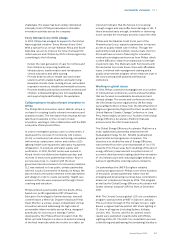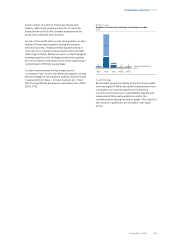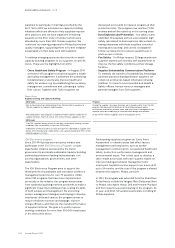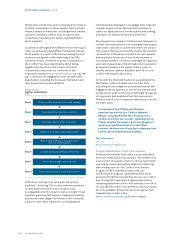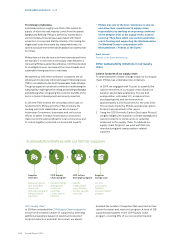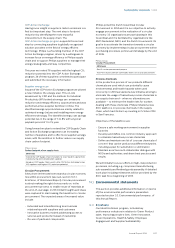Philips 2014 Annual Report Download - page 197
Download and view the complete annual report
Please find page 197 of the 2014 Philips annual report below. You can navigate through the pages in the report by either clicking on the pages listed below, or by using the keyword search tool below to find specific information within the annual report.Sustainability statements 14.2.7
Annual Report 2014 197
challenges. The paper has been widely distributed
internally to all of Philips businesses to stimulate
innovation activities across the company.
Every Woman Every Child pledge
In 2014, Philips has pledged its support to the United
Nations global initiative “Every Woman Every Child”.
With a special focus on sub-Saharan Africa and South
East Asia, we aim to improve the lives of at least 100
million women and children by 2025 in these regions by
committing to the following:
• Deliver the next generation of care for mothers and
their children by improving healthcare
infrastructures, transformation and revitalization,
clinical education and skills training.
• Provide better access to health care and create
solutions which enable healthier and safer living.
Examples include clean cooking stoves, automated
respiration monitors, eHealth and mHealth solutions.
•Promote healthy and nutritious diets for mothers and
children, understanding barriers to breastfeeding
and supporting breastfeeding in the workplace.
Collaborating on locally relevant innovation in
Africa
The Philips Africa Innovation Hub in Nairobi, Kenya, is
our base for creating locally relevant innovations and
business models. The Innovation Hub employs African
talents and operates on the concept of open
innovation, working in close collaboration with the R&D
ecosystem of Kenya and Africa.
In order to strengthen primary care in communities, it
developed the concept of Community Life Centers
(CLCs), a community hub where technology is bundled
with services: solar power, indoor and outdoor LED-
lighting, health care equipment, laboratory equipment,
refrigeration, IT-solutions and water supply and
purication. In 2014, the rst center was opened in
Kenya, which now delivers two babies per day, and
receives 13 times more patients than before. Key for
success was close co-creation with the local
government and involvement of community members.
CLC was realized in close public-private partnership
with the County Government of Kiambu in Kenya. We
also involved community members in the assessment
and design in order to create ownership. Health care
workers at the site were empowered through clinical
coaching and education.
Philips entered a partnership with the South-Africa
based non-prot organization PET (PowerFree
Education Technology) to further develop, test and
commercialize a Wind-Up Doppler Ultrasound Fetal
Heart Monitor, a unique, power-independent clinical
innovation aimed at addressing the high rates of
preventable infant mortality across Africa, designed
specically for low resource settings. Further
developed by the Philips Africa Innovation Hub, the
Wind-up Fetal Doppler is a device to detect a slowing
of the fetal heart rate while the mother is in labor, an
important indicator that the fetus is not receiving
enough oxygen and may suer brain damage or die. If
this is detected early enough, a midwife or delivering
nurse can take the necessary actions to save the child.
Philips and the Medical Credit Fund, part of the
PharmAccess Group, started a partnership to improve
access to quality health care in Africa. Through the
partnership small and medium-sized private clinics in
Africa will have access to nancing for innovative
medical technologies and services from Philips, which
is often dicult to obtain from banks due to the high
investment risks. The Medical Credit Fund works with
African banks to provide these clinics with aordable
loans, combined with management training and a
quality improvement program, which enhances trust in
the clinics among both patients and nancial
institutions.
Working on global issues
In 2014, Philips continued its engagement in a number
of international conferences, events and partnerships
that are focused on sustainable development and
climate change. The events and conferences include
the UN Climate Summit organized by UN Secretary
General Ban Ki Moon in New York, the World Summit of
Regions organized by Regions20 in Paris, as well as the
United Nations Climate Change Conference in Lima,
Peru. Most notably we were a co-founder of the Global
Energy Eciency Accelerator Platform that was
announced at the UN Climate Summit.
The Global Energy Eciency Accelerator Platform is a
multi-stakeholder partnership between the UN
(Sustainable Energy for All - SE4All), (sub)national
governments and progressive companies. The
objective is to double the rate of Energy Eciency
improvement from the current bandwidth of 1 to 1.5%
towards 2.5 to 3% per year. Such doubling of the rate of
energy eciency improvement is a potent driver of
economic development (creating jobs in the renovation
of city infrastructure and reducing budget decits), as
well as in signicantly reducing carbon emissions.
On partnerships the UNEP En.lighten initiative
continues to gain traction. Philips is one of the founders
of this public private partnership where now 66
emerging and developing countries have committed to
phase out incandescent lamps by 2016. This program
as well as the Global Energy Eciency Accelerator will
further develop towards COP21 in Paris in December
2015.
With The Climate Group a global ‘LED city consultation
program’ was launched at WEF in Davos in January.
This is a follow-through of The Climate Group’s ‘Light
Savers’ program that has piloted LED street lighting in
12 cities in all regions (including Sydney, Kolkata,
London, NYC, Toronto, and Rio de Janeiro) which
results were published in partnership with Philips
Lighting at Rio+20. The LED City consultation process
is identifying and addressing the (remaining) hurdles in












